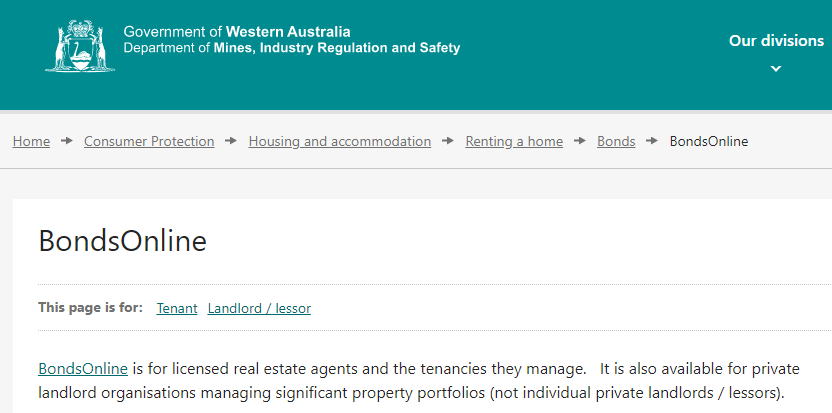Rental Bonds Explained

Welcome back rental property readers and in today’s post, we break down the murky and misunderstood world of the rental bond.
Here’s what we’ll cover:
- What is a rental bond?
- How much is a rental bond?
- Who holds the rental bond during tenancy?
- Landlords, when can you retain the rental bond?
- Property Condition Reports
- Getting the bond back – Bond Disposal
- How long does it take for bonds to be returned
Let’s discuss!
What is a Rental Bond?
A bond is money taken before the commencement of a lease to protect the owner to mitigate any losses stemming from renting out the property.
How Much is a Rental Bond?
Four weeks rent is the maximum you can take in Western Australia. Owners can decide to take less. There is also a maximum pet bond of $260; this is not a per pet amount, this is the total for all pets. There are some exceptional circumstances where the above may vary, these can be found in the Residential Tenancies Act 1987.

As you can imagine, I’ve heard some interesting theories about where bonds are kept and by whom.
Spoiler – property managers don’t hold the bond and neither do the owners employing the property managers.
Bonds in WA are held by the Western Australian Bond Administrator, a specific government managed trust account under the Department of Mines, Industry Regulation & Safety. You can get all the information you need about that department right here - https://www.commerce.wa.gov.au/consumer-protection/bondsonline
Once received, rental bonds must be lodged by landlords and property managers within fourteen days with the Bond Administrator.
Penalties for misuse, incorrect lodgement or failure to lodge in the mandatory fourteen day period can result in hefty fines. Recently, we heard about one self managed owner copping $24000 in fines in this REIWA article https://reiwa.com.au/information/renters/what-you-need-to-know-about-your-rental-bond-money/
As a professional property management company, automated systems are in place that link directly with the Bond Administrator for ease of lodging and disposal of bonds.
Landlords, When Can You Retain the Rental Bond?
A tenant is entitled to their bond in full if they leave the property in the same condition minus any fair wear and tear.
It is the description of “fair” that can lead to disputes.
For example, large coffee stains on what was a new carpet when tenants moved in will constitute as damage, not fair wear and tear and tenants will be liable for this damage.
Minor chips and marks on the wall would be considered fair wear and tear, however major dents and gouges would be damage. Chips in stone bench tops are also considered damage.
Not caring for gardens and lawns = damage. Mulch on the other hand is going to disappear over time, and is considered fair wear and tear and does need to be replaced by the tenant.
It’s not if the damage is intentional, life happens, but, tenants are liable for any damage they make to a property.
Property Condition Reports
A property condition report is a breakdown of every room with photos and thorough descriptions of the state of all aspects of the property. This includes walls, windows & window treatments, lighting, doors, floor coverings, power points, appliances, air-conditioning and more. They should be as detailed as possible, including both inside and outdoor areas.
The purpose of these reports is to have a benchmark from which to assess at the end of tenancy any and all damages and property changes that have occurred during tenancy.
A property condition report is required by legislation and will be the document that is referred to if bond disputes end up in court. Full details on the minimum requirements which the report must include can be found here: https://www.commerce.wa.gov.au/consumer-protection/property-condition-reports
If property condition reports are not completed properly, proving damages have occurred during a tenancy may be impossible. Even if they are completed properly and correctly track damages during the tenancy, this does not guarantee that the bond will cover the cost of these damages.

So What Does a ‘Detailed’ Property Condition Report Look Like?
Whether you are utilising a property manager or self managing your own portfolio, detail is the key to a good property management report.
Our property reports are usually upwards of fifty pages, including hundreds of photos and detailed descriptions of all aspects of the property.
Images are crucial and must be included. For example, a kitchen alone would usually be around sixty photos capturing bench tops, splash backs, outside of cupboards, inside cupboards, draws, oven, cooktop, range hood, floor skirting, lighting, switches, power points and anything else!
Remember, if it’s not documented in this report, you will not be able prove the damage claim at a later date.
Getting the Bond Back – Bond Disposal
When a tenancy comes to an end, the entry property condition report from when the tenancy started is compared with the current state of the property in an exit condition report.
Cleanliness is another aspect that is taken into account in the exit report. If tenants do not hand the property back in the same cleanliness state that it was began in, certain areas or the whole property can be stipulated for a vacate clean, which is payed for by the tenant.
If there is damage, owners need to be aware that new for old replacement is not always a viable outcome, as the Magistrates Court will always take depreciation into account.
It can often be more beneficial to negotiate with the tenant and attempt to settle a matter instead of ending up in court. Court costs must be considered in deciding whether to pursue a bond disagreement, and whatever the magistrate rules is final. In our experience, a magistrate is unlikely to order the replacement of a full bench top for example, if there is one chip or burn hole on the corner.
So rather than new for old replacement, compensation towards the replacement in the future can be a viable option.
For example, we had a tenant that took all reasonable measures to patch and paint a wall, including matching to the exact colour. Unfortunately the patches dried a different shade and the patches could be obviously seen. The owner accepted compensation of $100, towards the eventual repaint of the whole wall, instead of getting into a dispute and attempting to get the tenant to re-paint the entire wall.
How Long Does it Take for Bonds to be Returned?
In general, property managers work to release them as soon possible but there is a process that must be followed. We need to review the property, identify any issues, give the tenant the opportunity to rectify, get quotes and assess any outstanding rent and invoices. We also need to wait for the final water reading/bill to be issued so this can also be settled. Tenants also need to sign off on the bond disposal. Then, and only then, can we dispose of the bond. Once all reports and checks are completed, it usually takes three days for a bond to be transferred from the Bond Administrator into a tenants account.
That’s it today, I hope you now feel super informed on the what can be a difficult issue; the rental bond. Don’t forget to subscribe for more rental property management updates and analysis. Thanks for reading the Rent Choice blog, and we’ll see you next time.
Ready to get Started?
Talk to our team today and find out how we can help maximise your property's return.


.webp)
.webp)


